Restoring Life in the Oceans
Air Date: Week of April 2, 2021
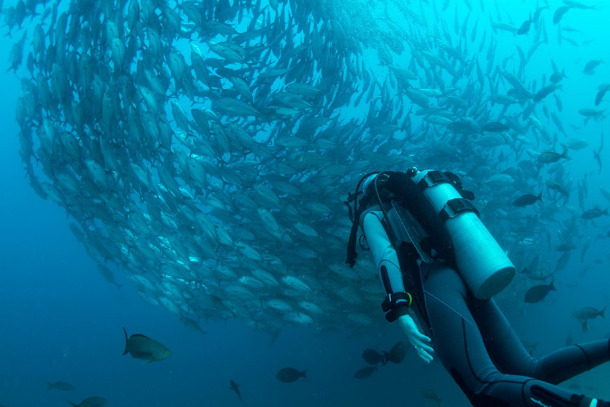
A diver faces a tornado of fish in Cabo Pulmo, Mexico. The creation of a protected area in Cabo Pulmo proved a boon for local fishermen, boosting the amount and diversity of fish. (Photo: Pascal Van de Vendel via Unsplash, CC 2.0)
Enric Sala’s love for the ocean drew him into a career in marine biology. But as he studied marine environments across the world that have been damaged by human activity, he began to feel he was writing the “obituary of the ocean.” So he left academia to advocate for protecting the oceans as a National Geographic Explorer-in-Residence and the founder of their Pristine Seas program. With special thanks to the New England Aquarium, Enric Sala talks with Host Aynsley O’Neill about his passion for convincing decision makers to create marine protected areas, with stunning results for ocean biodiversity and local economies.
Transcript
CURWOOD: It’s Living on Earth, I’m Steve Curwood
O’NEILL: And I’m Aynsley O’Neill.
Earlier in the broadcast we heard about reframing the ocean as a solution instead of a victim. A big part of that means helping the oceans recover from our overfishing, plastic pollution, and climate impacts. And we’ve got to hurry. Marine vertebrate populations declined by half between 1970 and 2012, according to the World Wildlife Fund. So when it comes to looking at the ocean as a solution, it’ll take someone with a bold vision. Someone like Enric Sala, Explorer-in-Residence for National Geographic and the cofounder of its Pristine Seas project. He’s always had his eye on that blue horizon.
SALA: When I was a little kid growing up on the Mediterranean coast, I was very close to the beach, which I visited every summer with my parents. And we were watching all Jacques Cousteau’s documentaries on TV. Since I can remember I wanted to be a diver, an explorer in Jacques Cousteau's boat.
O’NEILL: Oh, I love that. My father is a big fan of Jacques Cousteau, so.
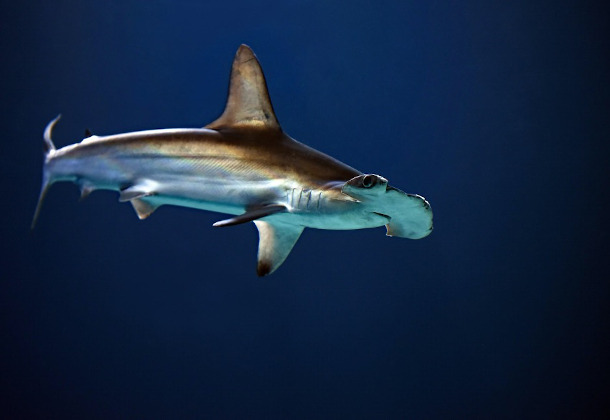
Hammerhead sharks are named for their unusual head shape. (Photo: David Clode via Unsplash, CC BY-SA 2.0)
SALA: Well I was born too late to be a diver in the Calypso, in Cousteau's boat, but the path that I took was science.
I decided to do my PhD studying a little marine reserve, an area where fishing is banned off the coast of Costa Brava in the Mediterranean coast of Catalonia. And then I became a professor.
But then one day I realized that all I was doing was writing the obituary of the ocean.
I was describing how ocean life was dying because of too much fishing and because of global warming. And that day I decided to quit academia and dedicate my life to bring back the richness and the productivity of the ocean.
[MUSIC: Blue Dot Sessions, “Shift Of Currents (Atmospheric var.),” Aeronaut, Blue Dot Studios 2020]
O’NEILL: Enric wanted to protect and restore places like the Galapagos Islands, which I was lucky enough to visit back in college for a study abroad program.
As far away as the islands are now, Enric took me back there in a heartbeat.
SALA: Yeah, I love the Galapagos Islands. Actually, the Galapagos Islands, they harbor the largest biomass of sharks ever measured in the ocean.
O’NEILL: Wow.
SALA: And you jump in the water. There is a shallow reef platform at around 30 feet. So you go down and you grab the rock for, [LAUGHS] you know, for your life, because the current is very strong. And then you just wait wait, wait, wait, wait.
[MUSIC: Blue Dot Sessions, “Leave the TV On,” Lemuel, Blue Dot Studios 2017]
And then after a while… one shadow came from the deep.
And then another one.
And then 10.
And then 100.
And then all of a sudden, you are seeing a wave of 200 hammerhead sharks swimming above you.
And then you think oh my god, I can die now, I have seen the most beautiful thing in the world.
And then when you think that you have seen it all, then you turn your head to the other side, and there comes a 40, 45 feet long whale shark. The biggest fish in the ocean.
So these are the type of things you can see at a wild place, like the Galapagos Islands.
[MUSIC FADES]
O’NEILL: Without those kinds of wild places, it’s impossible to even know what we’re missing.
SALA: As I mentioned earlier, when I was a little kid watching the documentaries of Jacques Cousteau, I was so excited to see all these big fish and the sharks and the dolphins and kelps. But then I went swimming in the Mediterranean and there was none of that. The sea floor was a barren ground with sea urchins. No kelps, no big fish, no dolphins, no seals, no sea turtles. And I was confused, and I thought that the Mediterranean was a naturally poor sea.
But then when I turned 18, and I was allowed to scuba dive, I took a diving course and my first dive in the sea was at this Medes Islands Marine Reserve, which had been protected for 9 years. And as soon as I got in the water, I realized, wow. This is what Cousteau showed us. This is what the Mediterranean used to be like. This is all that we have lost.
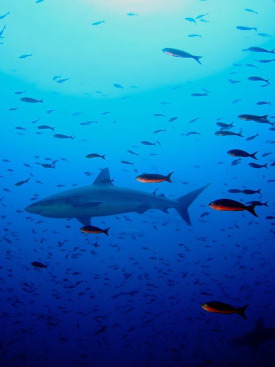
A Galapagos shark swims through a group of reef fish. The Galapagos Islands are home to the largest biomass of sharks ever recorded. (Photo: Daniel Kwok, CC BY-SA 2.0)
[MUSIC: Blue Dot Sessions, “Shift Of Currents (Original),” Aeronaut, Blue Dot Studios 2020]
O’NEILL: Bringing that back is what Enric now advocates for as an Explorer in Residence with National Geographic.
Their Pristine Seas program, which he founded, uses exploration, research, and media to convince presidents, governors, and local leaders to protect the wildest parts of the oceans with Marine Protected Areas.
These are basically nature reserves, or national parks, just for water instead of land.
The platonic ideal would be an area free of fishing, mining, and drilling.
And Enric knows first hand what that can do, even in a place that seems beyond repair.
SALA: The good news is that if we give the ocean space, marine life can comeback spectacularly. And I know because I have seen it.
O’NEILL: Tell us a little bit about one of those success stories where you've seen that in action and seen what can happen.
SALA: There is a place in Baja California, in Mexico called Cabo Pulmo. I was there in 1999, a couple of years after I arrived to my job at Scripps Institution of Oceanography. And the place was not very special except for the corals. There were not many large fish there.
The fishermen were so upset with not having enough fish to catch that they did something that nobody expected.
Instead of going after the last few fish left, which is what people normally do, they decided to create a no take area.
[MUSIC: Blue Dot Sessions, “Leave the TV On”, Lemuel, Blue Dot Studios 2017]
They asked the Mexican government to create a national park in the sea.
When we returned 10 years later, everything had changed.
That place that used to be an underwater barren was now a kaleidoscope of life and color.
[MUSIC GROWS, EXPANDS]
We were surrounded by snappers, moray eels, grunts, groupers. Everybody had come back, we saw it come back to pristine in only 10 years, I had never seen such abundance of life.
We actually measured fish, as good scientists, and compared the 2009 with the 1999 fish abundance; the tons of fish per hectare increased by 450%.
[MUSIC FADES OUT]
O’NEILL: Wow.
SALA: That was, that was the largest absolute recovery of fish abundance we've ever measured in a marine reserve worldwide. And we saw the return of the large predators, like the groupers, and the sharks, and the jacks. It's an extraordinary place.
And you know who else is thriving? Those visionary fishermen, who now are making far more money from diving tourism inside the reserve and better fishing around it.
O’NEILL: Wow. I can only imagine but I really want to see it myself! [LAUGHS]
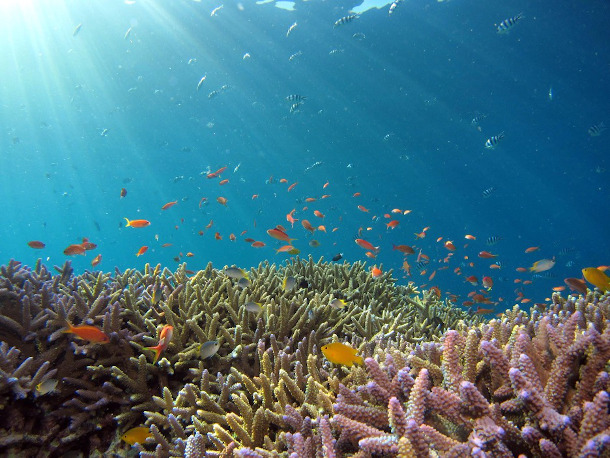
A coral reef in the Okinawa Sea blooms with life. Protecting key areas of ocean biodiversity with marine protected areas can have outsized, positive impacts on surrounding ecosystems. (Photo: Hiroko Yoshii, CC BY-SA 2.0)
[MUSIC: Blue Dot Sessions, “Leave the TV On,” Lemuel, Blue Dot Studios 2017]
SALA: You should go, it's an extraordinary place. It was some of the best diving in the world.
O’NEILL: After the break, we’ll dive into how Enric Sala gets people onboard with marine protected areas -- and whether or not the idea really holds water.
[MUSIC: Blue Dot Sessions, “Leave the TV On,” Lemuel, Blue Dot Studios 2017]
CURWOOD: To get the stories behind the stories on Living on Earth as well as special updates please sign up to the Living on Earth newsletter. Every week you’ll find out about upcoming events and get a look at show highlights and exclusive content. Just navigate to the Living on Earth website that’s LOE.org and click on the newsletter link at the top of the page. That’s LOE.org.
[MUSIC: Blue Dot Sessions, “Leave the TV On,” Lemuel, Blue Dot Studios 2017]
O’NEILL: Let’s dive back into our story about bringing back abundant life in the oceans with Enric Sala.
He’s the founder of the National Geographic Pristine Seas project, which advocates for creating Marine Protected Areas to preserve the wildest parts of the ocean in their natural state.
So, Cabo Pulmo is a shining case study of how no-take areas can help everybody, including fishermen
Still, how do you really convince decisionmakers? You’ve got to be realistic, Enric says…
SALA: When I was in academia, I thought that data was all that was needed.
That if decision makers, policymakers, had all the information about something, they would make a rational and informed decision.
But of course, I was so wrong. I was in the ivory tower, and I didn't know how the world worked. And when I left and came to National Geographic to start our Pristine Seas program, we learned very quickly that first we have to make people fall in love with these places.
O’NEILL: Now I feel like I've always been in love with the ocean, but if somebody is sort of reluctant, what's the best way to make someone fall in love with the ocean?
SALA: Every time we have taken somebody to one of these remote pristine places, they invariably fall in love with the place.
It is very difficult for a human with a heart and a soul to see such beautiful nature, it can be an old growth forest…
… it can be snow-capped mountains…
… it can be a pristine coral reef or a kelp forest.
It would be very difficult for a human to see these places and not fall in love with them. And I know there are people who are not so friendly to our life support system. And so probably these people lack heart and soul.
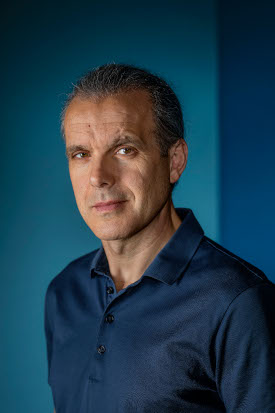
Enric Sala, PhD. is an explorer in residence at National Geographic and co-founder of the Pristine Seas project. (Photo: National Geographic)
[MUSIC: Blue Dot Sessions, “Shift Of Currents (Original),” Aeronaut, Blue Dot Studios 2020]
O’NEILL: And for those who lack the ‘heart and soul’, as Enric put it, that’s where the facts and data come in.
Before the break, Enric mentioned that the fishermen in Cabo Pulmo actually made more money after they designated the reserve - thanks to a sizable diving tourism operation.
Ecotourism in general is a massive industry - in the average non-pandemic year, it generates something like $265 billion dollars worldwide.
Places like Cabo Pulmo, the Galapagos, Rainbow Reef in Fiji, and of course the Great Barrier Reef in Australia are magnetic for divers and snorkelers from all over the world.
And if these travelers happen to stop by a gift shop or restaurant on their way, it’s all the more lucrative for the local economy.
That’s not to mention other ecosystem services that marine protected areas can provide: cleaning up wastewater, absorbing carbon dioxide, and pumping out oxygen for all of us on this planet to breathe.
And Enric says protecting these places demands that kind of scale.
SALA: The science is telling us that we need half of the planet, land and sea, in natural state, if we are to prevent the extinction of 1 million species, the collapse of our life support system, and if we are to achieve the goals of the Paris Climate Agreement. We need all these intact large ecosystems to continue absorbing much of the carbon pollution that we expel into the atmosphere. And we can start by committing to protect at least 30% of the ocean, fully protected, or highly protected, by 2030.
That’s what the science is telling us is the minimum that we require to make sure that the ocean continues providing for us.
[MUSIC: Blue Dot Sessions, “Open Flames,” Aeronaut, Blue Dot Studios 2020]
O’NEILL: 30% by 2030 seems like a tall order, and it is.
Right now, only 7 percent of the ocean is under some form of protection.
But it’s a start:
The United Kingdom has 355 marine protected areas, covering a quarter of their water, while Seychelles and Chile have already protected 30% or more of their own national waters.
And the gold medal goes to Palau, having protected 80% of their waters with a marine sanctuary that’s larger than “the Golden State”, California.
So some countries are leading the charge in marine protection.
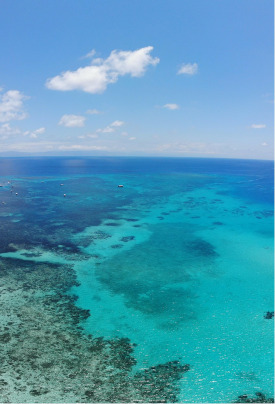
The Great Barrier reef is the world’s largest coral reef system. It is also a hub of lucrative ecotourism, where people come from all over the world to scuba dive and snorkel amongst the corals. (Photo: Carles Rabada via Unsplash, CC BY-SA 2.0)
And the US is moving in that direction too.
President Biden set a goal of setting aside 30% of land and ocean by 2030 with an executive order earlier this year.
Still, Enric isn’t letting his guard down.
SALA: Well, we have two problems here. One is that most of the protected areas are not protected enough. Most of these areas allow fishing within their boundaries.
And the second problem is that even if the areas are well regulated, they are not enforced. It is ridiculous that countries propose marine protected areas that allow commercial fishing, including bottom trawling, within their boundaries. You know, bottom trawling, which is a medieval practice for obtaining food where you have these huge nets that scour the bottom of the ocean to catch fish and shrimp, and everything that is caught and destroyed and dead that is not commercial is thrown overboard. And it just takes one pass of the net to kill everything, including thousand year old corals.
So these areas are not protected, they should not be called protected. This is a joke. So we need to make sure that most of these areas that allow so much commercial fishing are fully protected.
Because what the science is telling us is that the higher the level of protection, the greater the benefits for everybody, including fishing. These no-take areas, these fully protected marine areas, are savings accounts with a principle that we set aside, that grows like compound interest, and produces returns that we all can enjoy, including the fishermen.
O’NEILL: So let's say, miracle of all miracles, tomorrow, we have protected 30% of the ocean and it's even being enforced. Goodness gracious. How long is it going to take the oceans to recover even with that?
SALA: We have been able to detect differences, significant increases in marine life, within three to five years. For some species, it's very fast: there was a moratorium of fishing anchovies in northern Spain, it only took two years for the fish to come back.
In Cabo Pulmo in less than 10 years we saw it come back to pristine. In other places, like in Kenya or Fiji, small marine reserves helped to increase, in some cases double, the income of the fishermen in only three years.
It's very easy to fall into the doom and gloom, because there are many problems affecting the ocean. But the good news is that if we give space to the ocean, ocean life comes back spectacularly. I know because I've seen it. We just need to do it again and again and again.
[MUSIC: Blue Dot Sessions, “Open Flames,” Aeronaut, Blue Dot Studios 2020]
O’NEILL: That’s Enric Sala, cofounder of Pristine Seas and explorer in residence at National Geographic.
(Special thanks to the New England Aquarium for assistance with this segment.)
Links
The Pristine Seas Project at National Geographic
VIDEO: Why Are Marine Protected Areas Important? | Scripps Oceanography
Living on Earth wants to hear from you!
Living on Earth
62 Calef Highway, Suite 212
Lee, NH 03861
Telephone: 617-287-4121
E-mail: comments@loe.org
Newsletter [Click here]
Donate to Living on Earth!
Living on Earth is an independent media program and relies entirely on contributions from listeners and institutions supporting public service. Please donate now to preserve an independent environmental voice.
NewsletterLiving on Earth offers a weekly delivery of the show's rundown to your mailbox. Sign up for our newsletter today!
 Sailors For The Sea: Be the change you want to sea.
Sailors For The Sea: Be the change you want to sea.
 The Grantham Foundation for the Protection of the Environment: Committed to protecting and improving the health of the global environment.
The Grantham Foundation for the Protection of the Environment: Committed to protecting and improving the health of the global environment.
 Contribute to Living on Earth and receive, as our gift to you, an archival print of one of Mark Seth Lender's extraordinary wildlife photographs. Follow the link to see Mark's current collection of photographs.
Contribute to Living on Earth and receive, as our gift to you, an archival print of one of Mark Seth Lender's extraordinary wildlife photographs. Follow the link to see Mark's current collection of photographs.
 Buy a signed copy of Mark Seth Lender's book Smeagull the Seagull & support Living on Earth
Buy a signed copy of Mark Seth Lender's book Smeagull the Seagull & support Living on Earth

